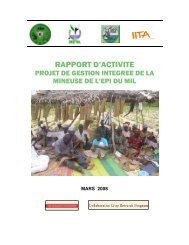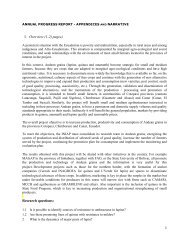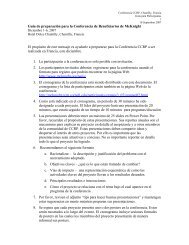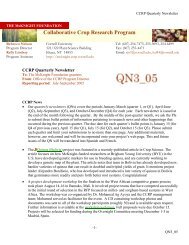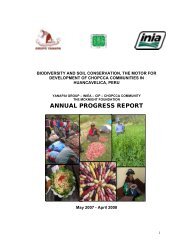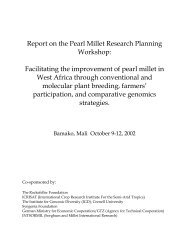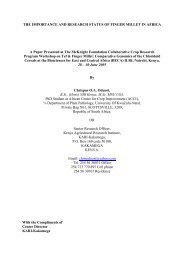English - McKnight Foundation Collaborative Crop Research Program
English - McKnight Foundation Collaborative Crop Research Program
English - McKnight Foundation Collaborative Crop Research Program
Create successful ePaper yourself
Turn your PDF publications into a flip-book with our unique Google optimized e-Paper software.
<strong>McKnight</strong> <strong>Foundation</strong> <strong>Collaborative</strong> <strong>Crop</strong>s <strong>Research</strong> Project No: 06-741<br />
Development and promotion of Alectra resistant cowpea cultivars for<br />
smallholder farmers in Malawi and Tanzania<br />
administered to 511 randomly selected farmers. Samples of local cowpea varieties and<br />
products prepared from cowpeas were collected for analysis in a laboratory at Sokoine<br />
University of Agriculture. The processing and preparation steps of cowpea recipes and<br />
products were documented.<br />
Proximate analysis of the samples<br />
The food samples for chemical analysis were grounded to pass through a one millimeter<br />
screen in a Christy and Norris 20cm laboratory hammer mill. Dry Matter percentage (%<br />
DM) was determined by drying the sample in an oven at 103 ºC – 105 ºC for 24 hours.<br />
Crude protein percentage (% CP) was determined by Kjeldahl method AOAC method<br />
No. 920.87 (AOAC, 1995) with the Kjeltec auto 1030 analyzer, whereby percentage<br />
Nitrogen obtained was used to calculate the % CP using the relationship: % CP = % N x<br />
6.25 (FAO, 1995). Ether Extract percentage (% EE) was determined using the Soxtec<br />
System HT- extraction technique AOAC method No. 922.06 (AOAC 1995) and<br />
percentage ash (% minerals) was determined immediately after the dry matter<br />
determination by incinerating the samples in a muffle furnace at 550 ºC for four (4)<br />
hours. The ash was cooled in a desiccators and then weighed. Crude fiber percentage (%<br />
CF) was determined by using the fiber system and Weende method (AOAC 1995).<br />
Nitrogen free extract percentage (% NFE) was calculated by differences as shown: %<br />
NFE = 100 - (% moisture + % CP + % EE + % CF + % Ash).<br />
Total minerals<br />
Total mineral content of the samples was carried out after dry ash. The ash was dissolved<br />
in a solution of 1:1 ratio of H2O : HCL, in which the concentration of the final mixture<br />
was 6NHCL. Total iron, zinc and calcium were determined by atomic absorption<br />
spectrophotometry by AOAC method 970.12 No. (AOAC, 1995).<br />
Data analysis<br />
Data for minerals and proximate analysis were entered in SPSS 12.0 for windows<br />
computer software. Descriptive statistics was used to determine the measures of central<br />
tendency for each analyzed cowpea variety. An analysis of variance of the results was<br />
done at 95% confidence interval (P≤0.05) using Tukeys Honestly Significant Difference.<br />
Homogeneity test was performed to determine homogenous sets.<br />
Results<br />
Demographic characteristics of farmers<br />
There were 240 interviewed farmers in Iringa of whom 124 (52%) were males and 116<br />
(48%) were females. In Dodoma 277 farmers were interviewed, 135 (49%) were males<br />
and 142 (51%) were females (Table 1). Farmer’s age ranged between 18 to 83 years with<br />
a mean of 45±15 years while in Dodoma the range was between 20 and 59 years with a<br />
mean of 35±7 years. In the two regions, the majority of the farmers had only studied up<br />
to class 7 (57% in Iringa and 88% in Dodoma) which is primary school level. However,<br />
5% and 1% of interviewed farmers had no formal education in Iringa and



